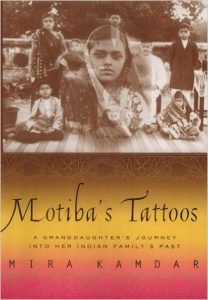
Motiba’s Tattoos
A Granddaughter’s Journey from America into her Indian Family’s Past
In a lyrical memoir spiced with mouth-watering Indian recipes and old family photographs, Mira Kamdar takes us back to the ancient world into which her grandmother was born: a tiny village in Kathiawar, India. Kamdar traces the Indian diaspora, following her family as it emigrates from feudal, rural India at the beginning of the century to the bustling streets of Rangoon, Burma and glamorous Bombay. In 1949, Kamdar’s father is packed off to the US, marking the beginning of the great westward Indian immigration. We see how he and his children, incuding Mira, grapple with their multi-ethnic identity in post-modern California. Kamdar touches on historical moments – Satygraha and the Indian independence movement, World War II, the “brain drain” years – but she keeps her memoir alive with rich details of her family’s lives.
– REVIEWS –
- Thrity Umrigar
- Seattle Times
- Amitav Ghosh
- Library Journal
- Abraham Verghese
- Seattle Times
- Amitav Ghosh
- India Today
“A fascinating tale of two women separated by personal history, geography, and time, but bound by family ties and mutual affection.” Thrity Umrigar, The Washington Post
“Kamdar provides evocative descriptions of the sights, sounds, smells and tastes of India . . . her family’s story illuminates a much larger picture of the Indian experience in the 20th century.” Seattle Times
“The history of the Gujarati diaspora is one of the great unwritten narratives of pre-modern globalization. This finely written, well-researched memoir is not just an important first step towards the telling of this story: It is also a very good read.” Amitav Ghosh, author of The Sea of Poppies and The Hungry Tide
“Kamdar brilliantly captures the experience of the Indian diaspora in the twentieth century. Highly recommended.” — Library Journal
“Colorful, poignant, humorous, and beautifully told.” Abraham Verghese, author of Cutting for Stone and My Own Country
“Kamdar provides evocative descriptions of the sights, sounds, smells and tastes of India . . . her family’s story illuminates a much larger picture of the Indian experience in the 20th century.” Seattle Times
“The history of the Gujarati diaspora is one of the great unwritten narratives of pre-modern globalization. This finely written, well-researched memoir is not just an important first step towards the telling of this story: It is also a very good read.” Amitav Ghosh, author of The Calcutta Chromosome and The Glass Palace
“[MOTIBA’S TATTOOS] is the story of leaving home, severing roots, and losing one’s tribe . . . a triumph of sorts for the family and yet another colorful addition to the complex cultural mosaic that is America.” India Today
